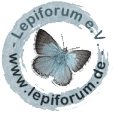

 +2Kontinente:NA
+2Kontinente:NA2. Biologie
2.1. Nahrung der Raupe
Noch unbekannt! Es wird vermutet, dass sich die Raupen in Früchten von "manzanita" (Arctostaphylos sp., Ericaceae) entwickeln.
3. Weitere Informationen
3.1. Andere Kombinationen
- Lampronia fuscoleuca Braun, 1923 [Originalkombination]
3.2. Taxonomie
Davis (1978) hatte diverse Exemplare von "Lampronia fuscoleuca Braun, 1923" und kam dabei zum Schluss, dass sie in eine neue Gattung gehören, die er Tridentaforma nannte. Doch Zweifel an der Zugehörigkeit zu den Incurvariidae blieben. Nachdem auch vermehrt genetische Daten vorlagen, beschrieb Davis (2015) in Regier et al. (2015) eine neue Familie für diese einzelne Art. Sie steht jetzt vor den Incurvariidae in der Überfamilie Adeloidea. Eine 2. Art sollte 2025 folgen: Tridentaforma browncopper.
3.3. Faunistik
Die Art ist nach [mothphotographersgroup.msstate.edu] aus den USA nur von verschiedenen Fundorten in Kalifornien bekannt. Vor diesem Hintergrund ist die Meldung von Pohl et al. (2019: 468) für Kanada sehr überraschend: "Globally there is only one described species of Tridentaformidae, Tridentaforma fuscoleuca (Braun). It was placed in the Incurvariidae at the time of Munroe (1979). It was unknown in Canada at that time, but was discovered since then, in British Columbia and Alberta. No BINs are available and no additional species are expected in Canada." Nachdem jetzt aber genau aus British Colombia Barcodes vorliegen, und diese völlig von T. fuscoleuca abweichen, ist sehr zu vermuten, dass die Tiere aus Kanada alle zu jener neuen Art gehören: Tridentaforma browncopper.
(Autor: Erwin Rennwald)
3.4. Literatur
- Erstbeschreibung: Braun, A. F. (1923): Microlepidoptera: Notes and new Species. — Transactions of the American Entomological Society 49 (2): 115-127. [Zum Digitalisat auf digital.library.cornell.edu]
- Davis, D.R. (1978): Two new genera of Incurvariine moths. — The Pan-Pacific Entomologist, 54: 147-153. [Digitalisat auf biodiversitylibrary.org]
- Davis, D.R. (2015): Description of Tridentaformidae, fam.n. — S. 27-29. In: Regier, J.C., Mitter, C., Kristensen, N.P., Davis, D.R., Van Nieukerken, E.J., Rota, J., Simonsen, T.J., Mitter, K.T., Kawahara, A.Y., Yen, S-H., Cummings, M.P. & A. Zwick (2015): A molecular phylogeny for the oldest (nonditrysian) lineages of extant Lepidoptera, with implications for classification, comparative morphology and life history evolution. — Systematic Entomology, 2015: 1-34. DOI: 10.111/syen. 12129. [PDF auf edisciplinas.usp.br]
- Pohl, G.R., Landry, J.-F., Schmidt, B.C. & J.R. deWaard (2019): Lepidoptera of Canada. — ZooKeys, 819: 463–505. doi: 10.3897/zookeys.819.27259. [zum Artikel mit PDF-Download auf pensoft.net]
- Regier, J.C., Mitter, C., Kristensen, N.P., Davis, D.R., Van Nieukerken, E.J., Rota, J., Simonsen, T.J., Mitter, K.T., Kawahara, A.Y., Yen, S-H., Cummings, M.P. & A. Zwick (2015): A molecular phylogeny for the oldest (nonditrysian) lineages of extant Lepidoptera, with implications for classification, comparative morphology and life history evolution. — Systematic Entomology, 2015: 1-34. DOI: 10.111/syen. 12129. [PDF auf edisciplinas.usp.br]




